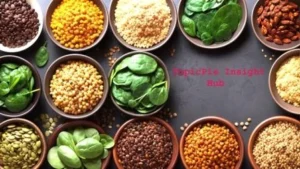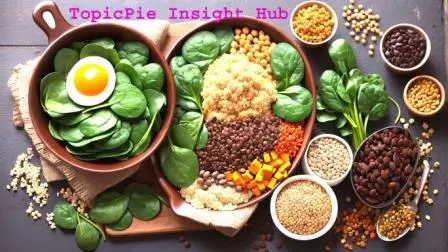Iron is an indispensable mineral that lies at the heart of our overall well-being, playing a pivotal role in sustaining our health. While it’s commonly associated with meat-based diets, a treasure trove of iron-rich vegetarian foods exists, waiting to be explored. Whether you’re a steadfast vegetarian or simply seeking to diversify your iron sources, this comprehensive guide is your passport to discovering the world of iron-rich vegetarian foods, offering you a natural boost for your health.
“Iron-Rich Vegetarian Foods” is the phrase of the day, and we’re about to embark on a journey through the top choices that will help us to maintain robust health. In this blog, we will delve deep into the realm of iron and nutrition, shedding light on the power of plant-based iron sources. From the verdant world of spinach to the humble lentil, the versatile tofu, and the beloved chickpea, these iron-rich heroes are about to take center stage.
But why is iron so crucial? Iron plays a multifaceted role in our bodies, facilitating the creation of red blood cells and the transportation of oxygen to every nook and cranny. Without it, our energy levels plummet, our immune system falters, and our cognitive prowess dwindles.
Traditionally, iron is categorized into two forms: heme iron, found in animal products and efficiently absorbed. Non-heme iron predominantly resides in plant-based foods, requiring more effort for our bodies to assimilate. This is where the beauty of iron-rich vegetarian foods comes into play. We discover how to meet daily iron needs and thrive on a nutritious, compassionate diet.

Spinach – A Leafy Green Powerhouse:
Spinach, often hailed as a nutritional powerhouse, takes the lead in our list of iron-rich vegetarian foods. This versatile leafy green is rich in non-heme iron, which, although not as readily absorbed as heme iron from animal sources, can still make a significant contribution to our daily iron intake. To maximize iron absorption from spinach, consider pairing it with vitamin C-rich foods like citrus fruits or bell peppers.
Spinach isn’t just an iron superhero; it’s also packed with other essential nutrients, such as folate, vitamin K, and fiber. These nutrients collectively support our overall well-being and help maintain a balanced diet. Whether we choose to sauté spinach as a side dish, toss it into salads, or blend it into smoothies, this green gem deserves a prominent place on our plate.
Incorporating spinach into a range of dishes showcases its versatility as a leafy green. From classic spinach salads to creamy spinach and artichoke dip, there are numerous delicious ways to enjoy this iron-rich vegetable. In addition to its iron content, spinach offers a plethora of health benefits. It’s an excellent source of vitamin A, which is essential for eye health, and vitamin K, which plays a role in bone health and blood clotting.
A Protein-Packed Iron Source:
Lentils are a vegetarian’s secret weapon when it comes to iron-rich foods. Not only do they provide a substantial amount of iron, but they also offer a healthy dose of plant-based protein and dietary fiber, promoting excellent digestion. Lentils come in various varieties, such as green, brown, red, and black, each with its unique flavor and texture.
These legumes are incredibly versatile and can be incorporated into numerous dishes. Simmer lentils in soups and stews for a hearty and iron-rich meal, or add them to salads for a satisfying crunch. Lentils also shine in Indian cuisine, where they star in dishes like dal, offering a flavorful and nutritious option for vegetarians.
Lentils are a nutritional powerhouse that goes beyond just iron. They are an excellent source of folate, a B-vitamin that is important for cell division and the formation of DNA. Additionally, lentils provide a significant amount of potassium, which is crucial for maintaining healthy blood pressure levels. The fiber in lentils aids in digestion and helps stabilize blood sugar levels.
Tofu – The Iron-Infused Plant-Based Protein:
Tofu, often called bean curd, is a popular plant-based protein source that’s also a fantastic supplier of iron. When it comes to tofu, opt for the firm variety, as it contains more iron than its softer counterparts. Tofu’s neutral taste makes it incredibly versatile and adaptable to various culinary styles.
To enhance the flavor of tofu, marinate it in favorite sauces and spices before cooking. Tofu can be stir-fried, grilled, baked, or even crumbled into dishes like scrambles or sandwiches. Its adaptability makes it a go-to choice for those seeking a balance of protein and iron in their vegetarian diet.
Tofu is not just an iron-rich food; it also provides essential amino acids, making it a complete protein source. This means it contains all the necessary amino acids that our body needs for proper functioning. Tofu is also a good source of calcium, which is crucial for strong bones and teeth. Incorporating tofu into our diet can help us meet our iron and protein needs while promoting overall health.
Chickpeas – A Nutrient Powerhouse:
Chickpeas, also known as garbanzo beans, are a cornerstone of many vegetarian diets, and for good reason. These little legumes pack a double punch, offering a generous amount of iron alongside substantial fiber and protein content. Chickpeas come in two main varieties: the larger, rounder Kabuli and the smaller, darker Desi.
Chickpeas can be enjoyed in numerous ways, making them a versatile addition to our diet. Toss them into salads for a satisfying crunch, blend them into creamy hummus, or incorporate them into hearty soups and stews. For a crunchy and iron-rich snack, roast chickpeas with favorite seasonings.
Chickpeas are not only iron-rich but also provide a host of other nutrients. They are a good source of vitamin B6, which plays a role in brain development and function. Additionally, chickpeas offer magnesium, which is essential for muscle and nerve function, and potassium, which helps regulate blood pressure. Including chickpeas in our diet can contribute to overall well-being.
Quinoa – The Complete Iron and Protein Grain:
Quinoa, often dubbed the “mother grain,” stands out for its high iron content and status as a complete protein source. Unlike many other plant-based proteins, quinoa contains all nine essential amino acids, making it an excellent choice for vegetarians.
This grain’s versatility knows no bounds. Use quinoa as a base for hearty salads, grain bowls, or serve it as a nutritious side dish. Its nutty flavor and slightly crunchy texture make it a delightful addition to various recipes. Quinoa also boasts other essential nutrients, such as magnesium, manganese, and phosphorus, further enhancing its nutritional value.
Quinoa’s gluten-free nature renders it appropriate for those with gluten sensitivities or celiac disease. It’s also high in fiber, which aids in digestion and helps maintain healthy cholesterol levels. Incorporating quinoa into diet can not only boost our iron intake but also provide a range of other health benefits.
Pumpkin Seeds – The Tasty Iron-Rich Snack:
Pumpkin seeds, also known as pepitas, are not just a tasty snack; they’re also packed with iron and a range of essential nutrients. These little powerhouses contain not only iron but also magnesium, zinc, and healthy fats, making them an excellent choice for boosting our overall health.
Snacking on pumpkin seeds throughout the day is an easy and convenient way to increase our iron intake. Sprinkle them on salads, yogurt, or oatmeal, or enjoy them as a standalone snack. Their satisfying crunch and savory flavor make them a favorite among health-conscious snackers.
Pumpkin seeds are a natural source of antioxidants, which help protect our cells from damage caused by free radicals. They are also rich in magnesium, which plays a role in various physiological processes, including muscle and nerve function, blood glucose control, and blood pressure regulation. Incorporating pumpkin seeds into our diet can be a simple and enjoyable way to promote your overall well-being.
Fortified Cereals – A Nutrient-Rich Breakfast Option
For a convenient daily iron intake, one might consider commencing their day with fortified cereals. Numerous breakfast cereals undergo fortification with iron and various other indispensable nutrients, rendering them a nutritious morning meal option.
When opting for cereals, one should focus on the iron content and opt for whole-grain choices with reduced sugar levels to ensure a nutritious beginning to the day. Pairing cereal with milk or a dairy-free alternative while incorporating fresh fruits can provide an additional nutritional boost. Fortified cereals not only provide essential nutrients but also offer a quick and easy breakfast solution for busy mornings.
Fortified cereals are an excellent choice for individuals who may have difficulty meeting their iron needs through other dietary sources. They are specifically formulated to provide essential nutrients, including iron, making them a convenient way to support our health. Additionally, the variety of flavors and textures available ensures that we can find a cereal that suits our taste preferences.
A Versatile Iron Source:
Black beans are a versatile and flavorful source of iron for vegetarians. These legumes not only supply a healthy dose of iron but also offer fiber, protein, and an array of vitamins and minerals. Black beans can be used in a wide variety of dishes, from burritos to soups and salads.
To incorporate black beans into our diet, consider making a zesty black bean salad with corn, tomatoes, and cilantro, or create a hearty black bean soup with spices and vegetables. The possibilities are endless when it comes to adding these iron-rich beans to our meals.
Black beans are not only a source of iron but also provide folate, which is important for DNA synthesis and repair. Rich in fiber, these foods support digestive well-being and contribute to stabilizing blood sugar levels. Additionally, black beans offer potassium, which is essential for heart health and blood pressure regulation. Including black beans in our diet can contribute to our overall well-being.
Sun-Dried Tomatoes – Flavorful and Iron-Packed:
Sun-dried tomatoes contribute delightfully to various dishes and might come as a surprise due to their iron content. These tomatoes, rich in flavor, find application in elevating the taste of pasta sauces, sandwiches, pizzas, and salads.
To incorporate sun-dried tomatoes into our diet, rehydrate them by soaking in warm water or oil, then use them in our favorite recipes. Their concentrated flavor and chewy texture provide a unique and savory element to a wide range of dishes, making them a versatile and delicious source of iron.
Sun-dried tomatoes not only add a burst of flavor to our meals but also offer a range of health benefits. They are rich in antioxidants, including lycopene, which is known for its potential to reduce the risk of certain chronic diseases. Additionally, sun-dried tomatoes provide vitamin C, which supports immune function and collagen production. Including sun-dried tomatoes in our diet can elevate both the taste and nutrition of our dishes.
Iron-Rich Vegetarian Foods: Dark Chocolate as a Delicious Supplement:
Yes, it’s true! Dark chocolate, boasting high cocoa levels, holds a moderate iron content. While it’s essential to consume chocolate in moderation due to its calorie and sugar content, enjoying a small piece of dark chocolate can be a delightful and indulgent way to supplement our iron intake.
When choosing dark chocolate, opt for varieties with higher cocoa percentages, as they tend to contain more iron and fewer additives. Savoring dark chocolate as a treat and contemplating its pairing with a handful of pumpkin seeds creates a satisfying and nutritious combination.
Dark chocolate offers more than just iron; it also contains flavonoids, which are plant compounds with antioxidant properties. These antioxidants may help improve heart health, reduce inflammation, and protect our cells from damage. Additionally, dark chocolate has been associated with mood improvement, making it a delightful indulgence that can enhance our overall well-being when enjoyed in moderation.
Iron-Rich Vegetarian Foods: A Crucial Component in Our Dietary Health
Maintaining a vegetarian diet that is rich in iron is not only beneficial for our health but also offers environmental and ethical advantages. Let’s explore the importance of iron in our diet, tips for enhancing iron absorption, and the benefits of choosing a vegetarian lifestyle.
Iron is an essential mineral that plays a critical role in various bodily functions. One of its primary functions is to transport oxygen throughout the body by aiding in the production of red blood cells. Iron is also involved in energy production, immune system function, and cognitive development. Without an adequate intake of iron, we may experience fatigue, weakness, and decreased immune function.
Two varieties of dietary iron exist: heme iron and non-heme iron. Animal-based foods contain heme iron, which the body readily absorbs. Non-heme iron, on the other hand, is primarily found in plant-based foods and is not as readily absorbed. This is why it’s essential for vegetarians to pay attention to their iron intake and incorporate iron-rich foods into their diets.
Iron-Rich Vegetarian Foods: Strategies to Optimize Absorption
While non-heme iron from plant-based sources is less readily absorbed than heme iron, there are several strategies one can use to enhance iron absorption:
- Pair Iron-Rich Foods with Vitamin C: Consuming iron-rich foods with vitamin C-rich foods can significantly improve iron absorption. For example, we can squeeze fresh lemon juice over our spinach salad or enjoy a glass of orange juice with our fortified cereal.
- Avoid Consuming Iron Blockers: Some substances can inhibit iron absorption. These include tea, coffee, and calcium-rich foods consumed in excess during meals. Try to consume these items separately from iron-rich foods.
- Cook in Cast Iron Cookware: Cooking acidic foods (like tomato sauce) in cast iron cookware can increase the iron content of our meals.
- Soak and Sprout: Soaking and sprouting grains, beans, and seeds can help reduce the phytic acid content, which can interfere with iron absorption.
- Balance our Diet: Ensure that our diet includes a variety of iron-rich foods to meet our daily iron needs.
Benefits of Choosing a Vegetarian Lifestyle through Iron-Rich Vegetarian Foods:
Opting for a vegetarian lifestyle not only supports our iron intake but also offers a range of health and environmental benefits. Here are some reasons why many individuals choose to embrace vegetarianism:
- Health Benefits: Vegetarian diets tend to be lower in saturated fats and cholesterol, making them heart-healthy choices. Additionally, vegetarians often have a lower risk of certain chronic diseases, such as hypertension, type 2 diabetes, and certain types of cancer.
- Environmental Impact: Plant-based diets have a lower carbon footprint compared to diets rich in animal products. By reducing meat consumption, we can contribute to a more sustainable and environmentally friendly food system.
- Ethical Considerations: Many people choose vegetarianism for ethical reasons, as it aligns with their values of compassion and animal welfare. Vegetarian diets do not involve the harm or exploitation of animals.
- Weight Management: Vegetarian diets are often associated with healthy weight management, as they tend to be lower in calories and higher in fiber-rich foods.
- Diversity and Creativity: Embracing a vegetarian lifestyle encourages culinary exploration and creativity in the kitchen. Discovering a wide range of delectable plant-based recipes and ingredients can infuse excitement into every meal.
Incorporating Iron-Rich Vegetarian Foods Into One’s Diet:
Equipped with knowledge about iron-rich vegetarian foods, their significance, and methods to enhance iron absorption, individuals can seamlessly incorporate these nutrient-rich options into their daily meals. A comprehensive approach involves crafting a weekly meal plan that boasts a diverse array of iron-rich vegetarian foods, guaranteeing sufficient iron intake.
For breakfast, consider beginning the day with a nourishing bowl of fortified whole-grain cereal, complemented by vitamin C-rich sliced strawberries and a scattering of pumpkin seeds. This wholesome meal pairs perfectly with a refreshing glass of freshly squeezed orange juice.
Also Read: The Power of Rare Earth Elements: Technology’s Hidden Gems
At lunchtime, embrace a spinach and lentil salad that takes center stage. This flavorful salad features cherry tomatoes, bell peppers, and a zesty lemon vinaigrette dressing. It harmonizes beautifully with a serving of hummus and whole-grain pita bread, creating a balanced and iron-rich midday option. For dinner, relishing a tofu stir-fry, filled with broccoli and bell peppers, bathed in a savory ginger-garlic sauce, while placing this delectable stir-fry atop a bed of quinoa, enhances the day’s iron intake.
The meal plan continues with a nutrient-packed smoothie for breakfast. It blends spinach, frozen berries, a ripe banana, and a scoop of plant-based protein powder. At lunchtime, savor a chickpea and quinoa bowl. Adorning it with roasted vegetables and drizzling it with tahini dressing offers a hearty and iron-rich option. Dinner introduces a flavorsome black bean and sweet potato chili. It’s infused with an array of spices and served alongside whole-grain rice. The following breakfast indulges in a hearty oatmeal, garnished with sliced bananas and a sprinkle of chia seeds, providing an extra boost of fiber. Lunchtime introduces a sun-dried tomato and black bean wrap, enveloped in whole-grain tortillas. Adding avocado slices and a drizzle of balsamic glaze elevates the flavor profile. Concluding the day, a square of dark chocolate, boasting a cocoa content of 70% or higher, offers a delightful dessert choice.
Conclusion:
In conclusion, embracing a diet rich in iron-packed vegetarian foods serves to bolster our iron intake. It also fosters overall health and vitality. The knowledge acquired about iron’s significance is essential. Diverse iron-rich plant-based options and absorption strategies equip individuals for a nourishing culinary journey.
By artfully designing a weekly meal plan, one can showcase the versatility of iron-rich foods and ensure a balanced diet. Breakfast offers fortified cereals. Lunch features vibrant spinach and lentil salads. Dinner brings flavorful tofu stir-fries with quinoa, allowing each meal to savor the goodness of plant-based iron.
The diversity continues with nutrient-dense smoothies, hearty chickpea and quinoa bowls, and tantalizing black bean and sweet potato chilis. The journey reaches its pinnacle with hearty oatmeal, sun-dried tomato and black bean wraps, and the indulgence of dark chocolate for dessert.
Incorporating these delicious options not only nourishes the body but also aligns with ethical and environmental considerations. It is a journey that celebrates not just health but also compassion, sustainability, and culinary creativity. With each delectable bite, we not only fulfill our iron needs but also savor the richness of a vibrant and nutritious vegetarian lifestyle. So, say goodbye to iron deficiency worries and embrace the boundless possibilities of a healthy life.









